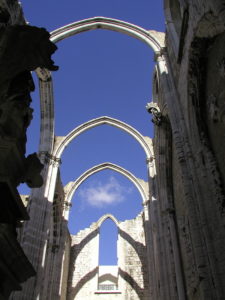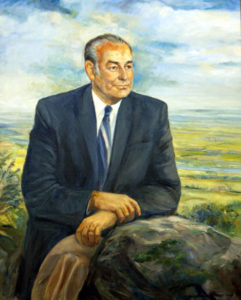calsfoundation@cals.org
Flipping the Page on the Modern Era
It’s hard to tell when you’ve turned the corner from one historical epoch to another. In fact, the argument could be made that very rarely is the break from one period to another so clean. Sitting in front of my television on September 11, 2001, the world felt like it had suddenly tilted hard, that nothing would be the same. But at a remove of more than twenty years, it becomes easier to see what happened post-9/11 as existing along the continuum of what came before. The United States intervened militarily in other nations but did not formally declare war, for example, continuing a “tradition” that followed World War II. Or you could also point out that the United States went to war but did not conscript soldiers, continuing a “tradition” that it had maintained since the end of the Vietnam War and relying upon an all-volunteer army. In fact, much of the political rhetoric surrounding 9/11 centered specifically upon maintaining a sense of normality, of continuity.
Of course, that continuity we can see also entails disruptions, new sets of expectations to which we have accustomed ourselves. We now think very little of removing shoes and stepping into full-body scanners before boarding a plane. Plus, the rhetoric surrounding terrorism has since assumed something akin to what legal scholar Bonard Iván Molina García would call “ontological branding” that separates it from the rhetoric of before. If at more than twenty years’ remove from 9/11, it can be easier to see how much didn’t change, it can also be harder to see exactly what radical departures we have adapted ourselves to.

But epochal changes are like that. Susan Neiman’s 2022 book Evil in Modern Thought: An Alternative History of Philosophy traces how philosophy of the last 250 or so years has been, in part, a response to the 1755 All Saints’ Day earthquake that struck Lisbon, Portugal, destroying the city and killing perhaps as many as 50,000 people. The earthquake was a catalyst in Enlightenment philosophy, forcing thinkers to confront issues of theodicy in novel ways that increasingly sidelined the alleged interventions and intentions of divine personages. But of course, if you weren’t a philosopher of the era but, instead, a farmer, chances are that very little of your general outlook on the world was changing. Too, those post-Lisbon Enlightenment thinkers did not derive their ideas ex nihilo but, instead, were employing (or seeking to disprove) the frameworks offered by their predecessors, such as Hume and Leibnitz.
Putting a pin in a moment and saying, “Here, after this point, everything will be different,” will always be a source of controversy and debate—but also necessary for us as we try to make sense of the world. Just as making a usable map entails decreasing the resolution of the image of whatever piece of geography you’re representing, so, too, will telling a usable history (especially for a general audience) entail some loss of resolution, of complexity; part of that will be chapter divisions that present our story in discrete chunks that emphasize certain themes.
Recently, at the Encyclopedia of Arkansas, we’ve decided to put a pin in a moment and close that particular chapter. As our readers will know, we have a number of time period overview entries covering broad swaths of history, such as the Civil War and Reconstruction or the early twentieth century. One of these entries was titled “Modern Era” and covered everything from 1968, with the election of Winthrop Rockefeller, up to the present day. Now, as you can imagine, that “present day” keeps going on, leaving more and more behind it, but at the same time, it’s rather challenging to realize, as you are living it, what exactly of this present moment will be considered noteworthy by those who follow. The entry remained rather open-ended, and the author, Ben Johnson, approached us last year about some major revisions, especially to incorporate mention of the COVID-19 pandemic. It was then that we began to chat about the possibility of tying off the “Modern Era” entry, as there had been some quite substantive changes in Arkansas politics and culture that argued for recognition.
After the most recent election, we decided it was time to flip the page. Working with Ben Johnson, we made a few last tweaks to his overview and renamed it “Divergent Prosperity and the Arc of Reform.”

On what basis did we decide a corner had been turned? The signal event that began the entry was the election of Winthrop Rockefeller, a Republican, to the office of governor. Not only was he the first Republican elected to that office since Reconstruction, but he was also a committed reformer who set to work trying to move the state beyond a corrupt one-party rule that benefited a handful of local elites but left everyone else out in the cold. And if he didn’t accomplish everything he had hoped, he nonetheless set the stage for later Democratic governors to follow the same path, rather than return the state to its Faubus-era corruption. The governors who came after Rockefeller, in one way or another, were responsive to how Arkansas was perceived by the outside world and sought to modernize its institutions.
The era we once dubbed modern was typified by an actual two-party system, even if Democrats ruled the roost through the early twenty-first century, with Arkansas being the last state to join the “Solid South” in terms of total Republican rule. This two-party system helped to spur the drive toward reform, as it offered an option to certain entrenched elites. So this explains the “arc of reform” part of our entry’s new title. What about “divergent prosperity”?

Arkansas has always offered divergent prosperity from back in the days when planters would keep most everything and the sharecropper would take home a pittance—or worse, just accrue more debt. But what typifies the era in question is how the drive toward modernization has not lifted all boats equally like the proverbial rising tide. During the time period under discussion, the Delta and southern Arkansas became even more depopulated while Little Rock and its suburbs grew, along with communities in northwestern Arkansas. Bentonville, for one, had a population of 5,508 in 1970, and it has since grown ten-fold, boasting 54,164 as of the latest census. By contrast, in 1970, Marianna had a population of 6,196, while it now has 3,575. And those are both county seats; smaller towns have taken an even bigger hit.
The urbanization of Arkansas seems a trend likely baked into the future, and the election of Asa Hutchinson in 2014 as governor returned the state to one-party rule. However, arguably, his governorship continued some of the trends toward reform present in earlier administrations, with his reorganization of state government hearkening back to an earlier effort in 1971. Too, Hutchinson seemed at times responsive to how Arkansas was perceived by the outside world in a manner that does not recall the pre-Rockefeller years, be it his hesitance to sign the so-called “Religious Freedom Restoration Act” in 2015 or his (albeit ineffectual) veto of Act 626 in 2021.
The latest election results have only cemented Arkansas’s place as a state of one-party rule, with the Democratic Party now akin to the Republican Party in the days of Faubus. You may think that good or bad, but however you feel, this is a major change that cannot be denied, just like the demographic changes that have given greater political, economic, and cultural weight to the Ozarks region once sparsely populated and perceived as backward. The world has been shifting beneath our feet this whole time, and no doubt these changes will continue. The election of November 8, 2022, did not mark an epochal upheaval after which everything was different. No—it was simply a convenient point at which to tie off this part of the story so that we can better perceive the movements that have been occurring over the last fifty years.
Early manuscripts of biblical texts did not divide themselves into chapter and verse—those were added much, much later for easier reference. That’s all any chapter break is—a point of reference. And that’s all we’re doing by bringing our so-called modern era to a close and giving it a new name. We’re flipping the page and continuing the story.
By Guy Lancaster, editor of the CALS Encyclopedia of Arkansas




